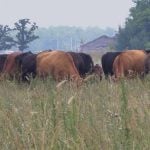When planning next spring’s crop rotations, producers should pay
particular attention to the herbicides used on last year’s crops.
“Most herbicides degrade through the activities of soil microbes and,
like other living things, microbes need moisture to survive,” said
Clark Brenzil, a weed control specialist with Saskatchewan Agriculture.
The drought likely means less residue than usual has degraded, he said.
Producers may want to contact the manufacturers of soil-residual
herbicides applied in 2001 to find the safest re-crop options on that
Read Also

Alberta eases water access for riparian restoration
Alberta government removes requirement for temporary diversion licence to water plants up to 100 cubic metres per day for smaller riparian restoration projects
land.
The Guide to Crop Protection has a list of soil-residual herbicides.
“But even crops cited as safe to plant after a particular herbicide can
vary in the level of tolerance,” Brenzil said.
“This may mean that producers who used soil-residual herbicides in 2001
may need to break rotational protocol and grow similar crops on that
field again in 2002.”
Growing the same crop back-to-back, however, invites the risk of
disease, said Penny Pearse, Saskatchewan Agriculture’s plant disease
specialist.
“Straw from the previous crop may harbour disease organisms that can
spread to this year’s crop.”
On the other hand, dry weather helps keep diseases at bay, so the
amount of disease inoculum on last year’s crop is likely low.
“While the risk of planting back-to-back is less for cereal crops, a
seed treatment may be considered,” Pearse said.
“There is greater concern about planting back-to-back pulse crops,
especially if that pulse crop is chickpea. Shortening a crop rotation
for a year is not generally a concern, but it should not be practised
over the long term.”
Brenzil suggested producers also look at their herbicide rotational
practices. While they should be concerned about the risk of herbicide
resistance under all conditions, lack of rain adds to the threat.
Consecutive applications of products in the same herbicide group under
dry conditions can lead to an additional load for the microbes to
handle.
“The same microbes break down products in the same group, and sometimes
overlap groups. Even organophosphate insecticides use the same microbes
for degradation as Group 2 herbicides.”
Brenzil noted problems from the last growing season. Pursuit or Odyssey
applications to peas grown on land treated with Everest the previous
year resulted in Group 2 injury to the crop. Areas that did not receive
two applications did not exhibit the same level of injury. Growing
conditions in all cases were dry.
“The good news is that injury occurred only when herbicides of the same
group were used in consecutive years,” he said.
“Furthermore, the manufacturer of Everest has subsequently changed its
label recommendation for peas to take moisture conditions into account.”
















